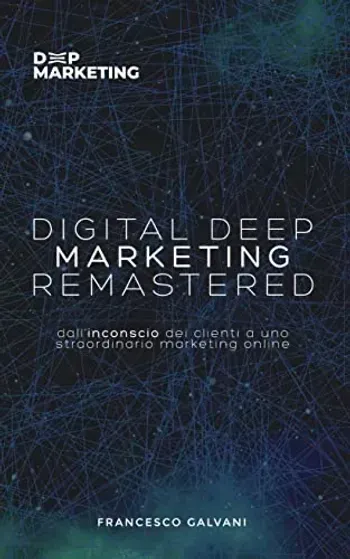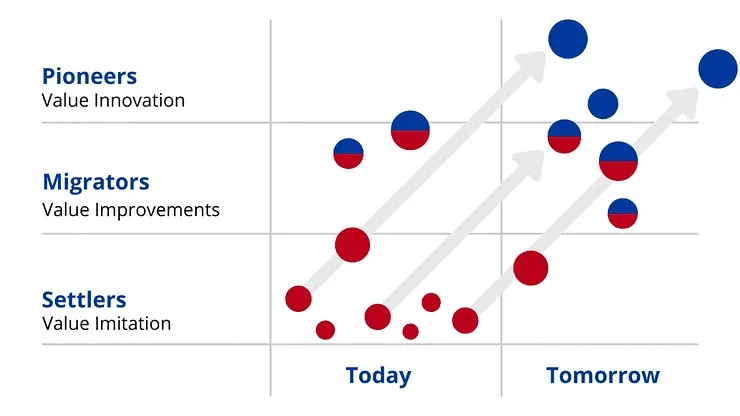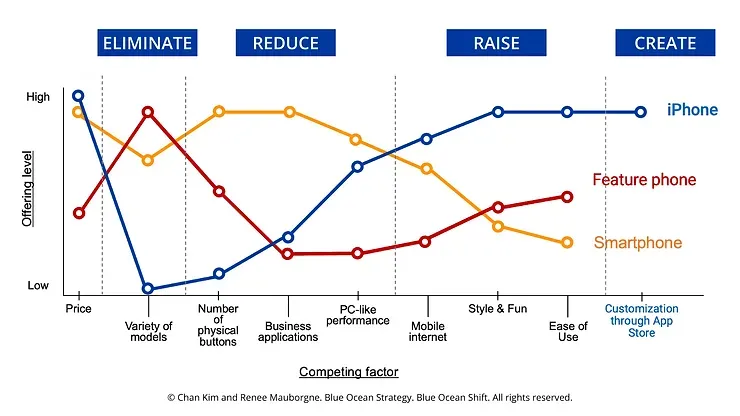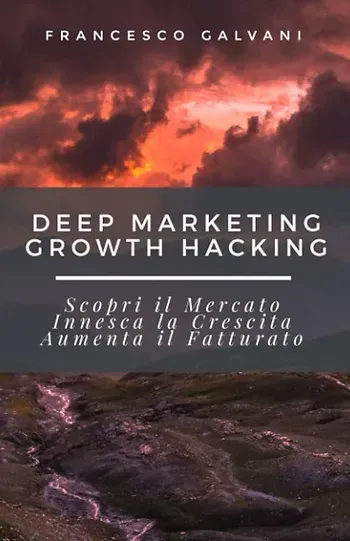The step-by-step guide to implementing the Blue Ocean Strategy in your business
Rilassati.
Con Deep Marketing hai la migliore agenzia veneta secondo IB Awards, credibilità e senior manager con 20 anni di esperienza.
Visibilità garantita su testate nazionali senza l'utilizzo di pubbliredazionali?
Prova la nostra incredibile promozione: se la nostra strategia non riesce a farti ottenere articoli reali dai giornalisti, ti rimborsiamo.
Introduction to the Blue Ocean Strategy
The Blue Ocean Strategy is an innovative approach to business strategy that focuses on creating new, uncontested market spaces by making competition irrelevant. Developed by W. Chan Kim and Renée Mauborgne , professors at INSEAD, this strategy challenges the traditional competitive approach of companies fighting for market share in crowded, mature industries, the so-called "red oceans".
The Blue Ocean Strategy instead proposes to create new markets, " blue oceans ", where competition does not yet exist. This is achieved through value innovation, i.e. the simultaneous pursuit of differentiation and low cost, expanding market boundaries and capturing new demand.
This strategy is particularly suitable for small and medium-sized enterprises (SMEs) which often do not have the resources to compete on equal terms with large players in existing markets. By creating their own blue ocean, SMEs can grow quickly and profitably, avoiding direct competition.
Blue Ocean news and key principles
Note that the idea of creating low-competition market spaces is not new and did not originate with Blue Ocean. On the contrary. In Italy, thanks to some ex-sales training gurus, Brand Positioning has recently spread, a strategy by consultants Jack Trout and Al Ries which in the 1970s aimed to obtain the same results as Blue Ocean, unfortunately with theories naive and repeatedly falsified by science and market research. Brand Positioning is today considered pseudoscience like the horoscope, while the Blue Ocean Strategy enjoys very solid evidence and exceptional case studies.
We remind you that the book " Digital Deep Marketing Remastered ", one of the volumes that made our agency known to the Italian public, represents a manual that draws some ideas from Blue Ocean but simplifies them and concretizes them for the digital world, combining them with evidence of the cognitive psychology.

The Key Principles of the Blue Ocean Strategy
Rebuild market boundaries: Look beyond traditional definitions of your industry and identify untapped opportunities.
Focus on the big picture, not the numbers: Don't be guided by data alone, but consider trends and qualitative insights.
Go beyond existing demand: Target non-customers and create a new demand.
Get the strategic sequence right: Align utility, price, cost and adoption from the start.
Overcome key organizational barriers: Align your people, processes and technology to support your strategy.
Integrate execution into strategy: Planning and execution must go hand in hand.
Steps to implement the Blue Ocean Strategy
Let's see together how your SME or the company you manage can effectively and successfully develop Blue Ocean. Step by step:
Step 0: The Team
It is crucial to first build the right team to lead the initiative, with people from different functions and levels of the organization. The team must be motivated, open to change and willing to question the status quo.
Step 1: Draw your Present Value Curve
The Value Curve is a tool that maps your company's performance against key competitive factors in your industry. Start by identifying these factors and evaluating your performance on each. This will give you a clear understanding of where you currently stand in the market.
You should choose the right area to focus on for Blue Ocean. It is necessary to identify the business areas with the greatest potential for value creation and fewer organizational constraints. Tools like the Pioneer-Migrator-SettlerMap can help identify the most promising opportunities.

Credits: Chan Kim and Renee Mauborgne, blueoceanstrategy.com
The first column represents the current state of the portfolio, while the second column depicts the desired situation for the future. Marketers can use the PMC Map to map group companies or product/service lines.
- Pioneers are businesses or offerings that provide unprecedented value to customers . Their value curve deviates markedly from their competitors and they enjoy a large market following. These businesses adopt Blue Ocean Strategies and constitute the most powerful levers for profitable growth.
- Migrators are businesses or propositions that offer superior value over rivals, but not disruptive value: they give customers more for less, without revolutionizing the industry's key competitive parameters.
- Settlers are offerings that provide customers with roughly the same value as competitors . These are so-called "me-too" businesses. While often the current cash cows , settlers typically will not contribute significantly to a company's future growth, as they are trapped in the red ocean of competition.
Step 2: Identify Untapped Opportunities
Start with the PMC map and look beyond your industry to identify untapped opportunities .
Consider alternative industries, strategic groups within your industry, the buyer pipeline, complementary product and service offerings, functional-emotional appeal to buyers, and even time. Ask yourself questions like:
“What industry assumptions can we challenge?”
“What customer needs are not yet met?”
Step 3: Redraw your Value Curve
Based on the opportunities identified, redesign your Value Curve. Consider what factors you should eliminate, reduce, increase, or create . The goal is to offer unprecedented value to customers, making the competition irrelevant. We will see below in the examples how to correctly implement this part.
In detail:
- Eliminate . Identify factors that the industry takes for granted but which no longer have value or even have a negative impact. For example costs, features or services that are no longer necessary. Dramatically eliminate these factors to differentiate yourself and reduce your cost structure.
- Reduce . Identify the factors on which the sector tends to exaggerate in an attempt to beat the competition, going beyond the real needs of customers. Significantly reduce your investment and effort on these factors to save resources.
- Increase . Determine the factors that should be increased well beyond industry standards to differentiate and create value for customers. Decisively increase investment and focus on these key factors.
- Create. Discover completely new sources of value for customers by creating factors never before offered by the industry. Create these new factors to attract new demand and radically differentiate yourself from competitors

Credits: Chan Kim and Renee Mauborgne, blueoceanstrategy.com
Step 4: Test and Refine your Strategy
Before launching your new strategy on a large scale, test it with a small segment of customers. Collect feedback and refine your strategy accordingly. This will help you mitigate risks and ensure your Blue Ocean strategy resonates with your target market.
This part is perfectly similar to the Growth Hacking processes for startups and new business areas covered in the book "
Deep Marketing Growth Hacking ".

Step 5: Align your Organization
Successfully implementing a Blue Ocean strategy requires aligning your entire organization. Make sure your people, processes and technology are aligned to support your new strategic direction. This may require reconfiguring resources, training staff and adopting new technologies.
This is why the main work team must be chosen wisely. They must be people with leadership and vertical competence.
Step 6: Launch and Iterate
Once your strategy has been tested and refined, it's time to launch it at scale. However, remember that the Blue Ocean strategy is not a one-off event. It requires continuous iteration and adaptation in response to changing market conditions. Remain alert to new opportunities and be ready to adjust course if necessary
Successful examples and case studies
Below, three "classic" case studies to understand how to think in "Blue Ocean" style.
Cirque du Soleil
One of the most famous examples of Blue Ocean Strategy is Cirque du Soleil, which reinvented the circus industry by focusing on a new market space: theatrical entertainment for adults willing to pay a premium price for a unique artistic experience.
Rather than compete with traditional circuses based on animals, tents and clowns, Cirque has eliminated or reduced these elements, adding live music and dance, evocative storylines and artistic performances in refined locations. It has thus attracted a new audience of high-spending adults, businesses and tourists.
In 20 years, Cirque du Soleil has achieved revenues equal to those achieved by leader Barnum & Bailey in 100 years, creating a blue ocean of live entertainment.
Nintendo Wii
Another example is the Nintendo Wii console which created a new market in gaming by targeting casual gamers, particularly women and the elderly, rather than traditional male gamers.
The Wii introduced an innovative motion-based controller, intuitive and fun games like Wii Sports, and a simple, attractive design. It has thus made gaming accessible to the whole family, creating new demand.
Launched in 2006, within a year the Wii outsold consoles from Sony and Microsoft, the industry's technological leaders, demonstrating how value innovation can beat computational power.
[yellow tail]
In the crowded wine industry, [yellow tail], an Australian brand, has created a blue ocean by focusing on simplicity and fun rather than the complexity and snobbery of premium wines.
[yellow tail] has eliminated the technical jargon, grape varieties and vintages of the labels, creating just two wines (one red and one white) that are easy to drink. It simplified the supply chain by focusing on a few key suppliers. And he's created a playful, casual brand that appeals to wine-intimidated "beer drinkers."
Launched in 2001, within two years [yellow tail] became the best-selling imported wine in the US, creating a new segment of "simple, fun wines" that expanded the market.
Frequently asked questions about the Blue Ocean Strategy
Does the Blue Ocean Strategy apply only to certain sectors or companies?
No, the Blue Ocean Strategy is a universal approach that can be applied in any sector, be it manufacturing or services, high-tech or low-tech, consumer or B2B. Examples of success can be found in the most disparate fields, from Cirque du Soleil in entertainment, to the Nintendo Wii in gaming, to [yellow tail] in wine.
What matters is not the industry itself, but the ability to challenge market boundaries and taken-for-granted assumptions to create an offering of innovative value. Even mature and stagnant industries can be revitalized by Blue Ocean moves that redefine the rules of the game.
Is it necessary to be a startup to create a blue ocean?
No, both startups and established companies can create blue oceans. Indeed, it is often incumbents with deep knowledge of the sector who identify and exploit new market opportunities.
Cases like the Nintendo Wii in gaming or Starbucks in coffee show how industry leaders can continually reinvent their business through Blue Ocean moves. The key is to maintain an entrepreneurial mindset open to innovation, even when you are number one.
How long does it take to implement a Blue Ocean strategy?
Implementing a Blue Ocean strategy can take anywhere from a few months to a year or more, depending on the size and complexity of your organization and the scope of your new strategy.
How can I overcome internal resistance to change?
Clear communication, employee engagement and strong leadership are key to overcoming internal resistance. Make sure everyone understands the reasoning behind your new strategy and their role in making it happen.
How do I measure the success of my Blue Ocean strategy?
Success can be measured in terms of new customers acquired, revenue growth, profitability and market share. However, also consider qualitative metrics such as customer satisfaction and brand recognition.
Do we necessarily have to use new technologies to create a blue ocean?
No, the Blue Ocean Strategy does not necessarily require high technology or cutting-edge R&D. Blue oceans often arise by creatively recombining existing technologies to solve customer problems in new ways.
For example, Cirque du Soleil combined elements of traditional circus with theater and dance, without introducing new technologies. The key is value innovation, not technology itself.
Do Blue Oceans last forever?
No, sooner or later every Blue Ocean becomes a Red Ocean, as competitors imitate the successful strategy and erode first-mover advantages. However, companies that continually create new blue oceans can thrive in the long term.
Companies like Apple, Amazon or Salesforce have made value innovation a strategic capability, systematically creating new markets and growing sustainably. The challenge is to institutionalize a non-disruptive creation process that continuously renews the business.
Where can I learn more?
As always in these cases we provide fundamental readings to proceed with the study:
[1] https://www.blueoceanstrategy.com/blog/five-steps-making-blue-ocean-shift/
[2] https://www.blueoceanstrategy.com/blog/7-powerful-blue-ocean-strategy-examples/
[3] https://www.blueoceanstrategy.com/tools/red-ocean-vs-blue-ocean-strategy/
[4] https://blog.hubspot.com/blog/tabid/6307/bid/54/blue-ocean-strategy-a-small-business-case-study.aspx
[5] https://www.blueoceanstrategy.com/blog/blue-ocean-qa-questions-answered/
[6] https://www.blueoceanstrategy.com/tools/5-steps-to-making-a-blue-ocean-shift/
[7] https://arounda.agency/blog/top-10-blue-ocean-strategy-examples
[8] https://www.blueoceanstrategy.com/what-is-blue-ocean-strategy/
[9] https://www.blueoceanstrategy.com/teaching-materials/all-cases/
[10] https://www.blueoceanstrategy.com/blue-ocean-shift-question-and-answer/
[13] https://www.cascade.app/blog/blue-ocean-vs-red-ocean-strategy
[14] https://www.youtube.com/playlist?list=PL6xJIk7SXpnFF1o-YRp38qlKh4GaJUiJS
[15] https://www.csus.edu/center/carlsen/_internal/_documents/tools/blue-ocean/blue-ocean-qa.pdf
[16] https://www.linkedin.com/advice/1/what-steps-create-blue-ocean-strategy-skills-strategy
[17] https://www.blueoceanstrategy.com/blue-ocean-strategy-examples/












